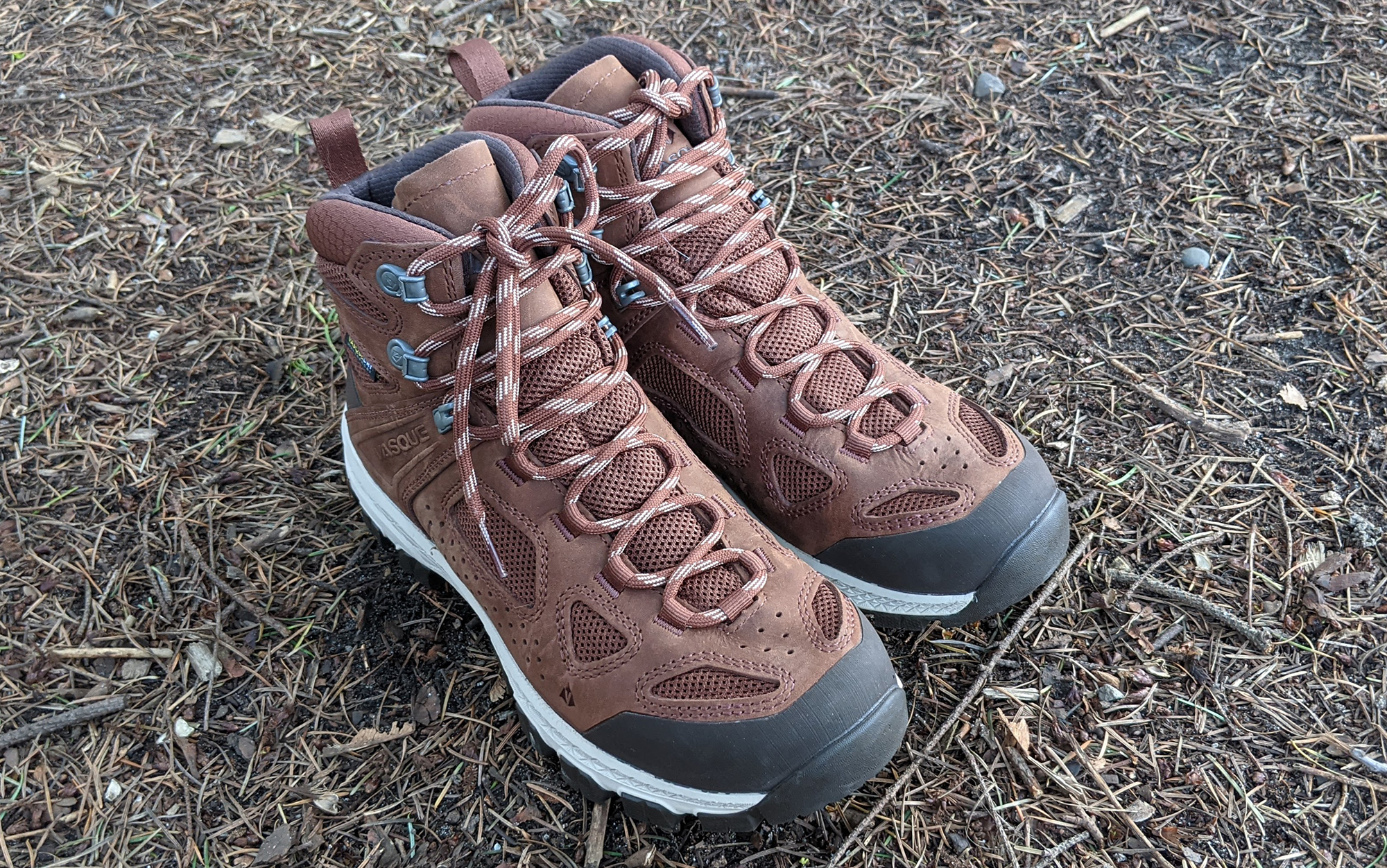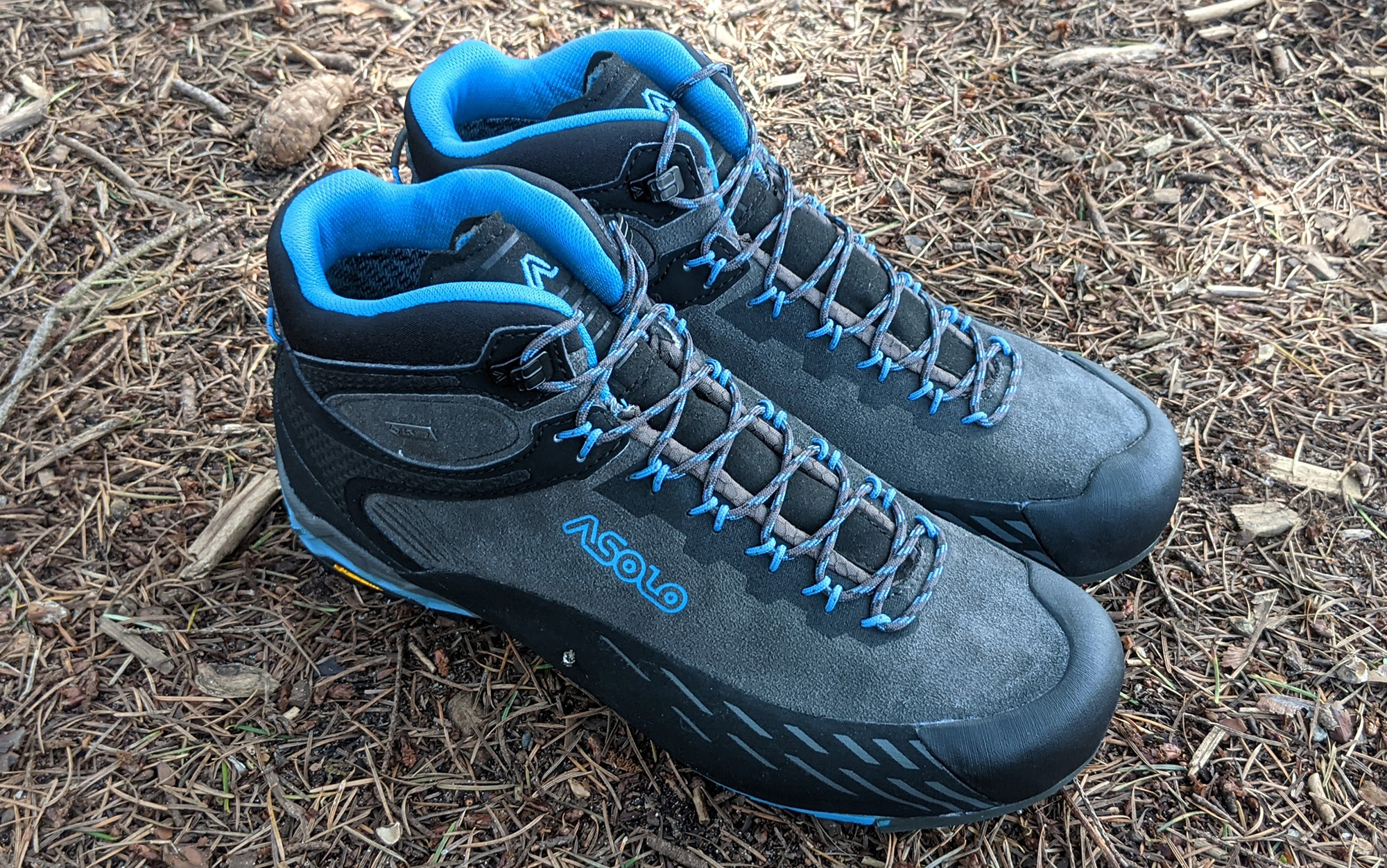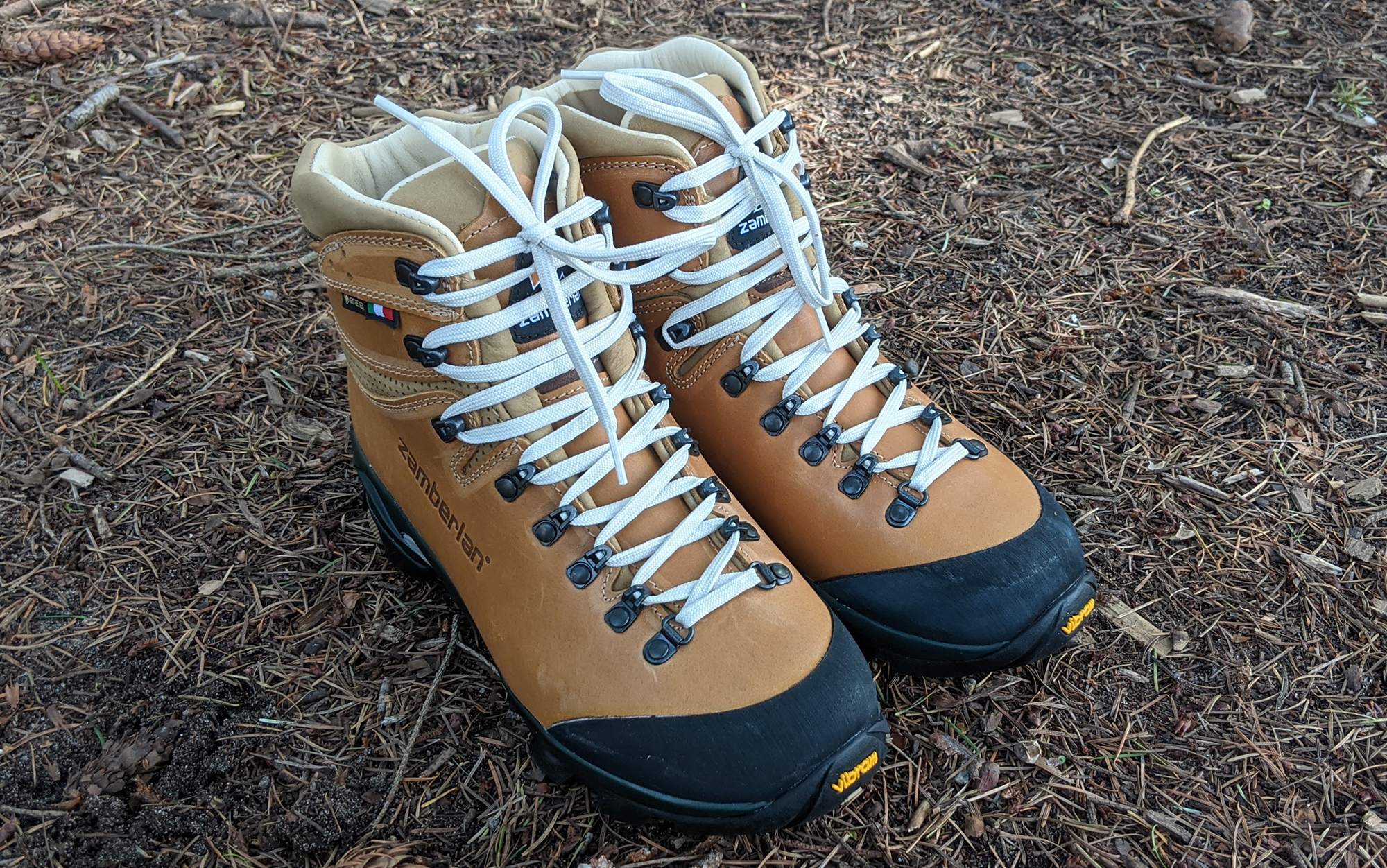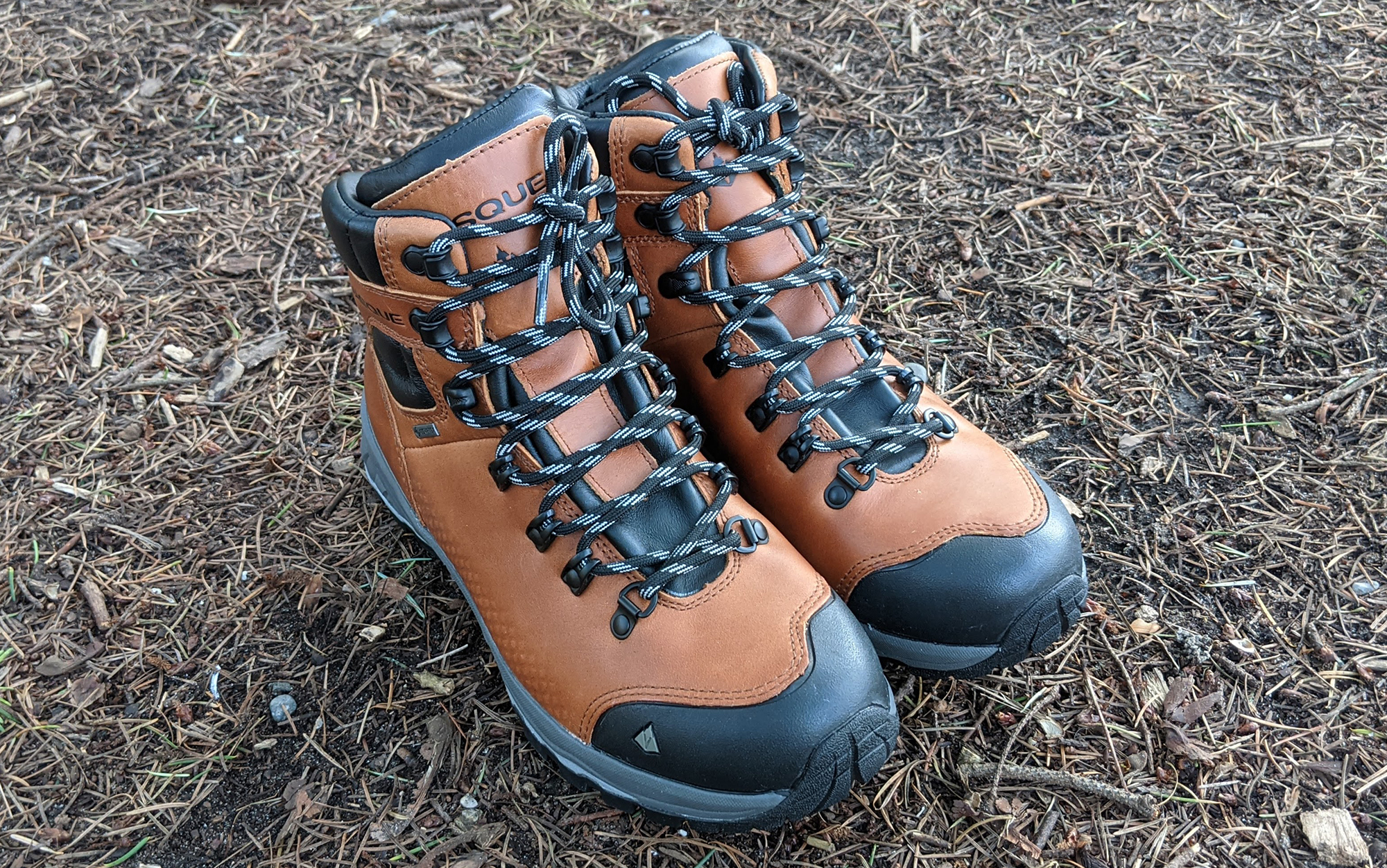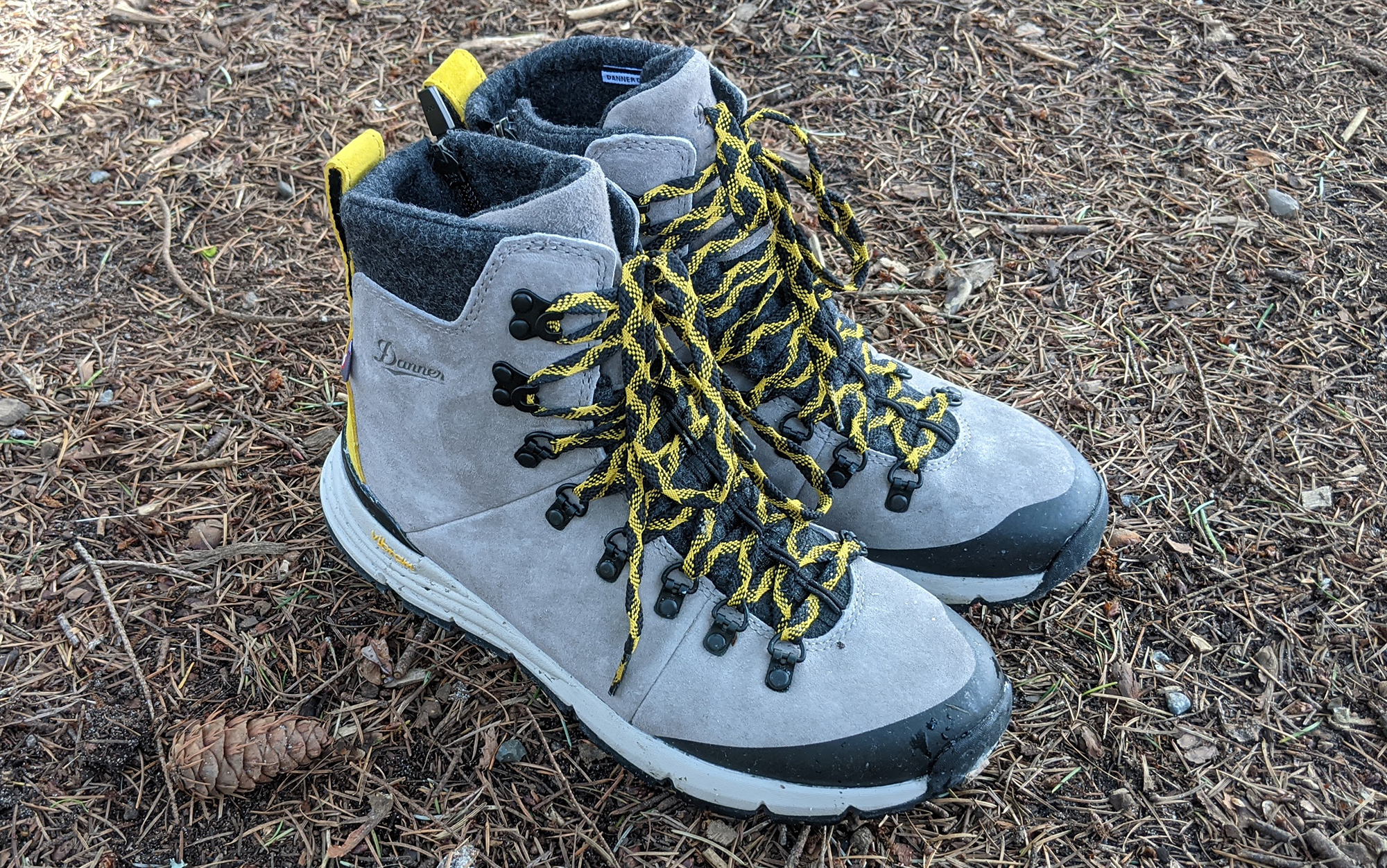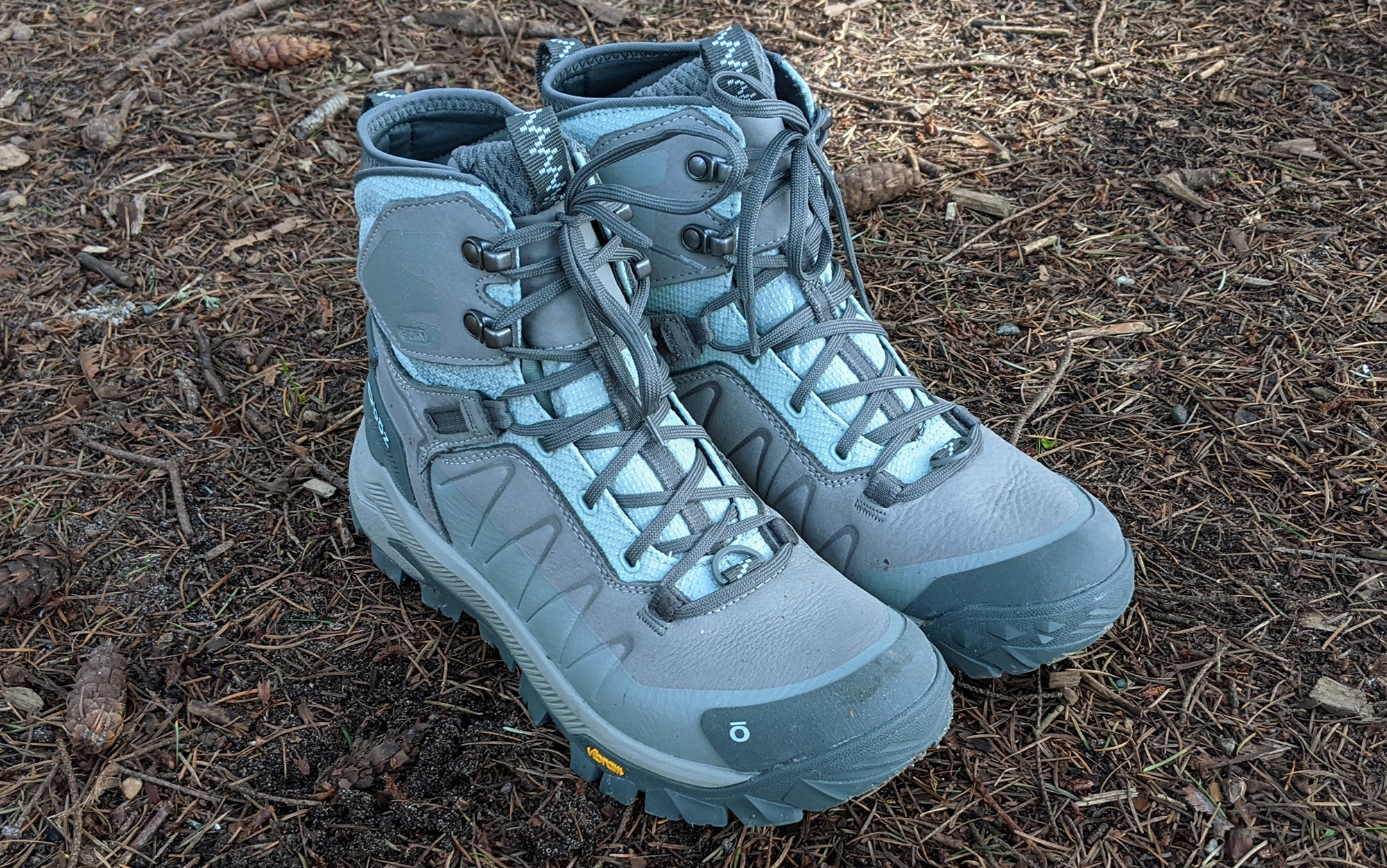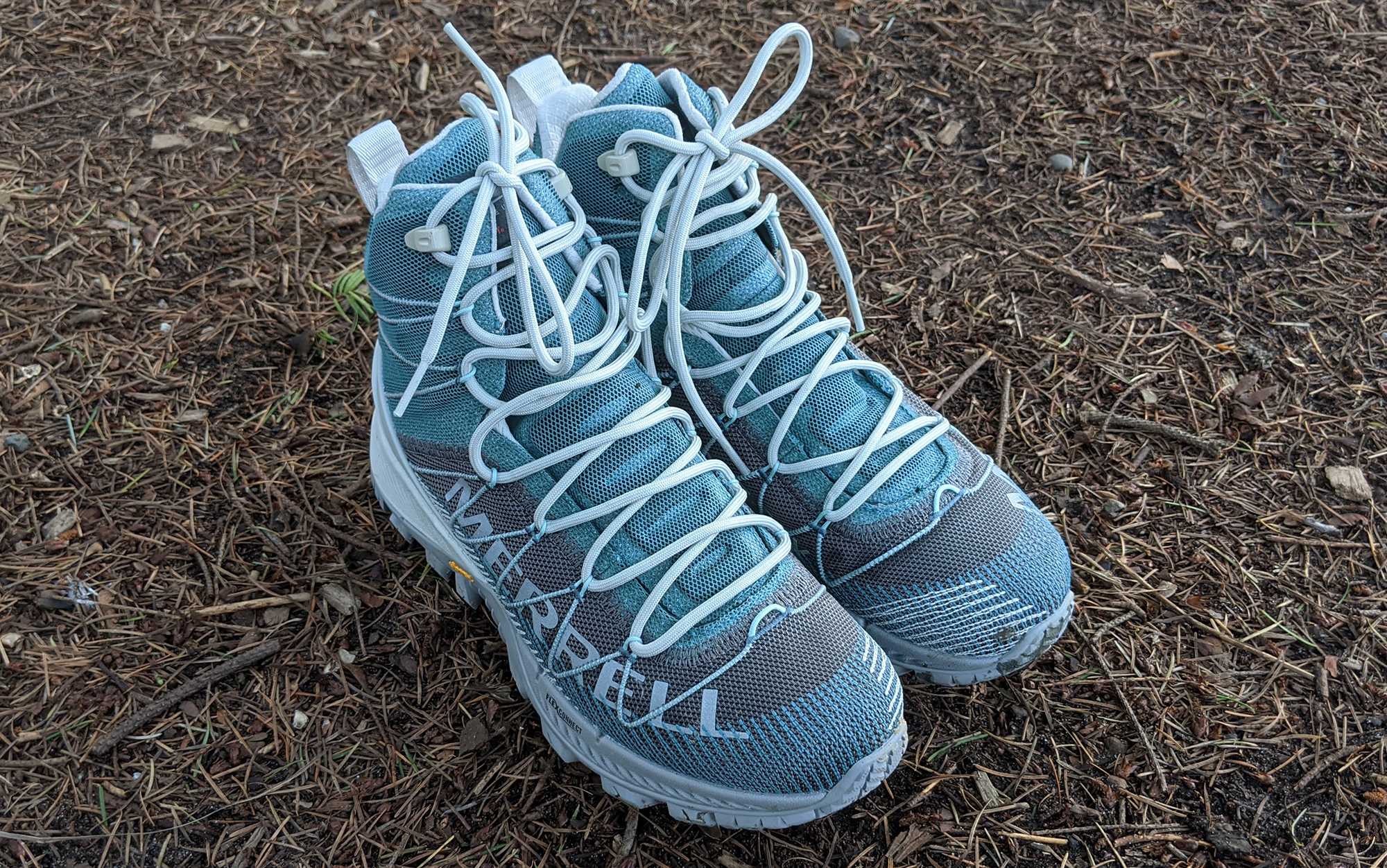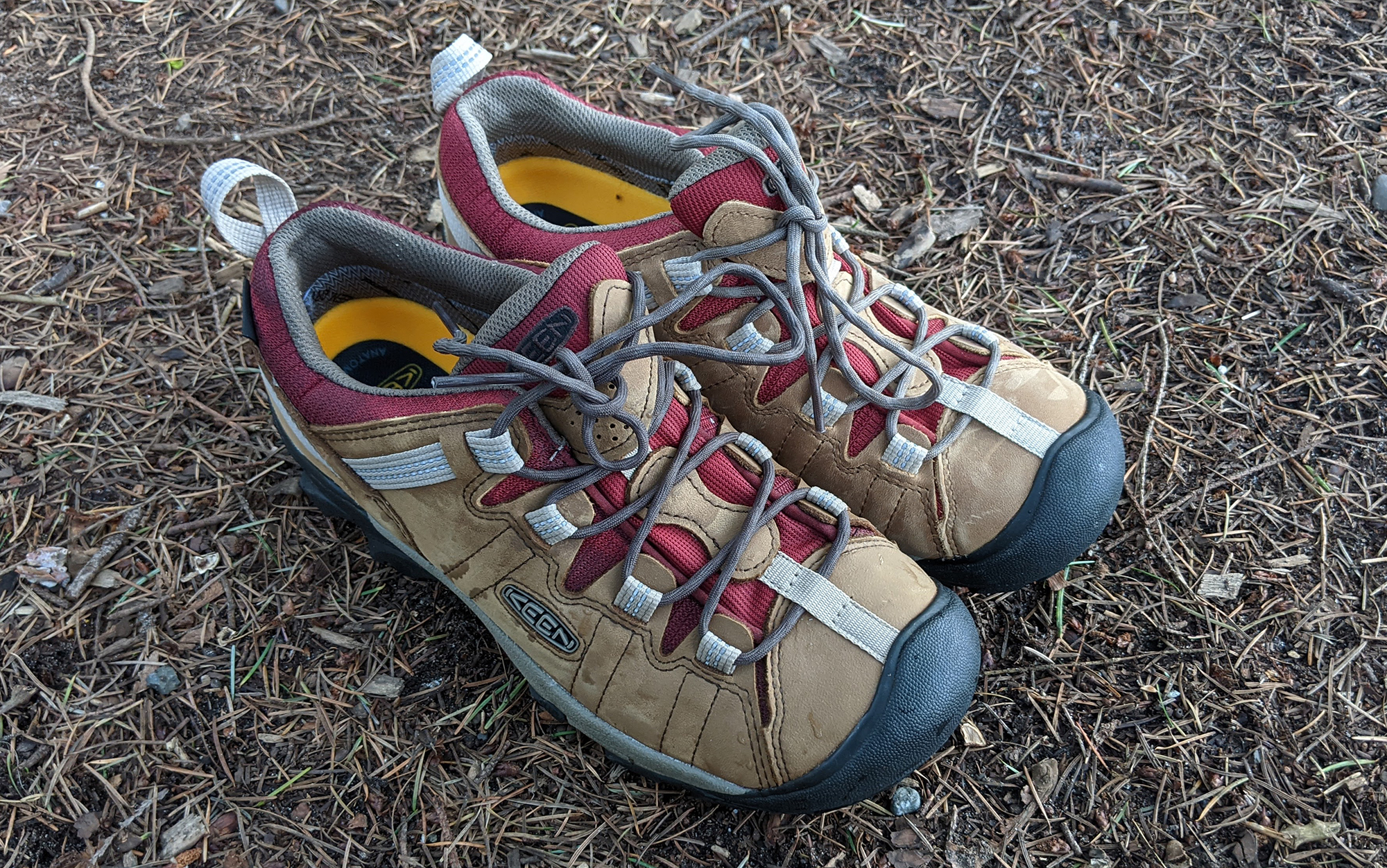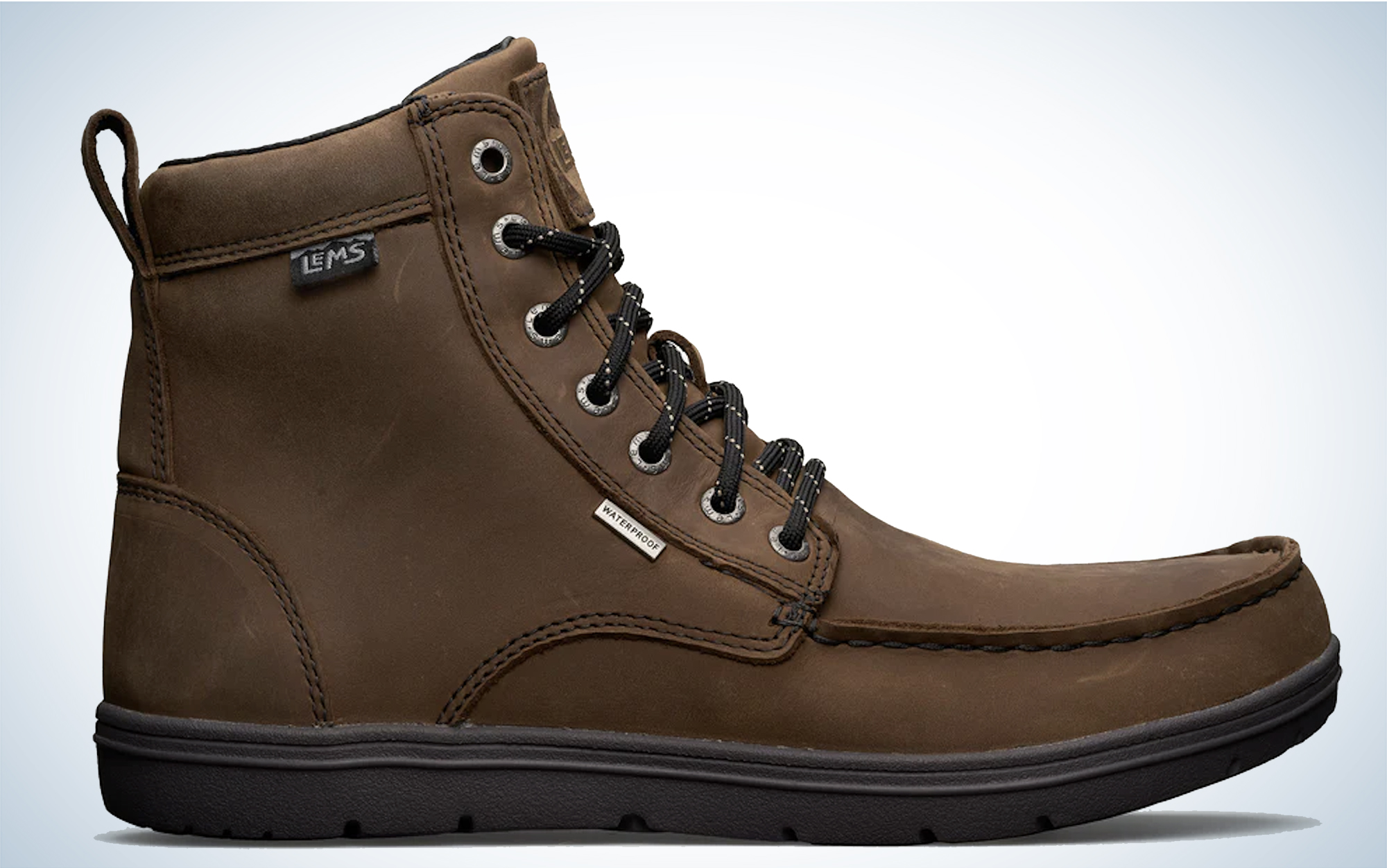We may earn revenue from the products available on this page and participate in affiliate programs. Learn More ›
Published Mar 23, 2023 5:30 PM
For plenty of people, waterproof hiking boots are a requirement for any trek with even a chance of rain. And there is good reason to take precaution: Wet feet can cause all sorts of issues, including blisters and even trench foot. But not all waterproofing is created equal, and it can be hard to tell, fresh out of the box, if a hiking boot is up to the challenge of keeping your feet dry through a myriad of conditions. To help you choose, I put the best waterproof hiking boots through a series of tests to find out which were truly waterproof and which were only water resistant.
How I Tested the Best Waterproof Hiking Boots
There’s good news if you already have a favorite hiking boot: There’s probably a waterproof version available. Most hiking boots get their waterproofness from a combination of a waterproof lining inside of the boot and a water repellent finish on the upper, which can be added to an existing, popular boot model. For this story, I focused on boots that are well-regarded by hikers for their durability and performance and which are also advertised as waterproof by their manufacturers.
The boots were put through a series of three tests to both assess how effective their waterproofing was and to see if that waterproofing increased the overall moisture retention on the interior of the boot.
16-Hour Submersion Test
I put each boot in 2-inches of water, and after sixteen hours I checked to see if any water had infiltrated the boots.
Deterioration Test
I took the boots to the beach. While most people won’t be hiking in salt water in their hiking boots (I’d recommend one of the best trail runners or one of the best water shoes for hiking for that), the salt that is found on roads during wintertime excursions can often cause damage to the waterproofing of even the best hiking boots. So after dunking them in the salty ocean, I then coated the hiking boots in mud, checking to make sure that the mud covered the connection point between the sole and the upper, as this is a frequent fail point.
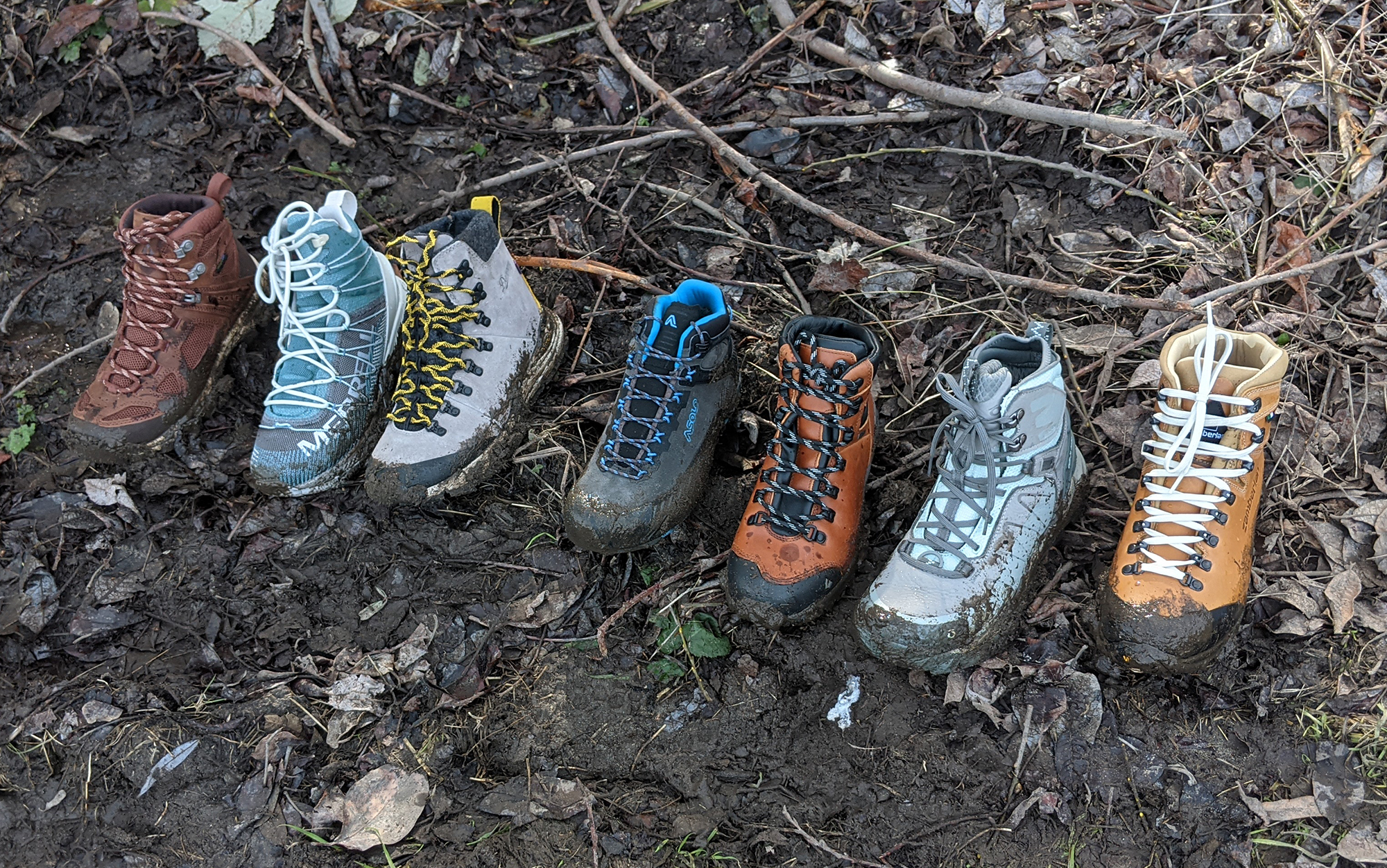
The waterproof hiking boots were then left outside for multiple days, in full sun during the day and with temps approaching freezing at night because UV rays and temperature shifts can break down glue and sealant. At this point, the boots were retested in the bathtub for a period of eight hours with water encroaching on the lacing system of each bootl.
Drying Test
I completely submerged each boot and compared how long it took for them to dry in a room with an average humidity of 30 percent.
When choosing a waterproof hiking boot, look for a model that fits your foot properly. All hiking boots fit slightly differently and what is best for one individual (or gear reviewer) may not be what is best for you. While I have not rated the below shoes for fit, I have provided notes where applicable to help inform your decision.
The Best Waterproof Hiking Boots: Reviews & Recommendations
Best Overall: Vasque Breeze
Key Features
- Sizes: Men’s 7-14; women’s 6-12
- Recycled polyester mesh, Nubek waterproof leather, Vasque Trail Strider outsole
- VasqueDry waterproofing
- Runs small and narrow
Pros
- Fully waterproof
- Affordably priced
- Dries fairly quickly
- Reasonably lightweight
Cons
- Tight fit may be uncomfortable for some
The Vasque Breeze scored well in every test I put it through: It was completely dry after being left in several inches of water for sixteen hours, and then stayed dry in my second test, where I threw all of the salt and mud and sun that I could at it and then left it again in submerged water. And it manages all that while coming in at a fairly affordable (at least for hiking boots) price tag. The lightweight design of the Vasque Breeze also offers more breathability than other waterproof hiking boots, and it performed well during the dry-time test.
I recommend sizing up for the Vasque Breeze (which runs small) and also walking around for some time before committing to a final purchase. This boot is on the narrow side, and some hikers may find that it is putting more sideways pressure on the forefoot than they prefer.
Best for Sufferfests: Asolo Eldo Mid
Key Features
- Sizes: Men’s 8-13; women’s 5.5-9.5
- Water-resistant suede with Asolo/Vibram AG with MegaGrip compound
- Gore-Tex Extended Comfort Footwear lining
- Fits true to size
Pros
- Very lightweight for a boot
- Fast drying time
- Protected midsole
Cons
- Not as waterproof as other boots I looked at
The Asolo Eldo Mid is built for tough conditions. Its minimalist lacing design securely tightened around my foot with my heel locked in place. It features a grippy sole that is perfect for slippery rock. And it’s lightweight, with each shoe clocking in at well under a pound. And not only was this boot perfectly watertight during the first round of testing (thanks in part to the water-resistant suede wrapped around the connection point between the midsole and the upper), but it also dried surprisingly fast.
The only downfall of this shoe was the second test. The combination of torture treatment (my treatment of the boots in this test is far from best practice) plus higher water levels meant that it was completely soaked after eight hours. Scramblers expecting a monsoon should not grab this boot, but, then again, scramblers are probably not headed out in a monsoon anyway.
Most Comfortable: Zamberlan 1996 Vioz
Key Features
- Sizes: Men’s 8-15; women’s 6-11
- Full-grain waxed leather with Zamberlan Vibram 3D
- Gore-Tex performance comfort lining
- Fits true to size
Pros
- Fully waterproof
- Very comfortable
- Wider toe box
Cons
- Long dry time
- Very expensive
I gotta level with you: I don’t, personally, love hiking boots, waterproof or not. Sure, I’ll wear them when conditions warrant it, but give me the option and I’ll always grab a pair of the best minimalist shoes for hiking.
The one boot that is the exception to this is the Zamberlan 1996 Vioz. You can tell just by looking at this shoe that its quality is top-notch, but put it on and the softness and suppleness of the leather makes it clear that this is one of the most comfortable hiking boots out there. If you’re looking for a quality leather waterproof hiking boot with a shorter break-in time, this is the one.
During testing, this shoe stayed fully waterproof through both rounds of testing, but was one of the slowest to dry. Be careful if you’re hiking near or around high water as you will be unlikely to dry out this shoe until you are back in the frontcountry.
Best Leather: Vasque St. Elias
Key Features
- Sizes: Men’s 7-14; women’s 6-11
- Materials: Nappa leather with Vibram Frontier with XSTrek compound
- Gore-Tex performance comfort technology
- Runs very small and narrow
Pros
- Fully waterproof
- Fast drying
Cons
- Not appropriate for larger volume feet
- Expensive
While the Zamberlan 1996 Vioz took top honors for comforts, the true highest-performing waterproof leather hiking boot in my test was the Vasque St. Elias. Not only was this boot fully waterproof during both rounds of testing, it was also one of the fastest drying models I looked at, drying as fast as the likes of the KEEN Targhee and the Asolo Eldo Mid. Truly impressive performance for a leather boot.
The main issue with this hiking boot is that, in addition to running very small (consider sizing up an entire size for this one), it also has an unusually low foot volume. I have an average-volume foot and after wearing this boot for only a couple of minutes I could feel the circulation start to be cut off to my toes.
Best for Winter: Danner Arctic 600
Key Features
- Sizes: Men’s 7-14; women’s 5-11
- Nylon with Primaloft Gold and Vibram Nisqually Arctic Grip
- Danner Dry liner
- Fits true to size
Pros
- Winner of my best winter boot test
- Fully waterproof
Cons
- Slow drying
- Side zip represents a point of failure
The Danner Arctic 600 just squeaked by with top honors in my test of the best winter boots and survived both waterproofing tests with nary a drop. The Vibram Arctic Grip outsole (in combination with this shoe’s lug design) was, in particular, extremely impressive. The stickiness of the traction meant I could barely tell I was walking on ice—it was almost impossible to slip with these shoes. Similarly this shoe stayed warmer than every other boot in my test while standing in the early spring runoff of the Middle Fork of the Snoqualmie River, and no moisture made its way into the boot. That being said, the Danner Arctic 600 took an exceedingly long time to dry, so be careful not to step into any water sources that are higher than the top of the boot.
The Danner Arctic 600’s side zipper was an unusual feature among the boots that I tried. While putting on and taking off boots seemingly every fifteen minutes, I appreciated that I could put on and remove these shoes without having to untie and retie the laces. But as everyone who spends time outdoors knows, zippers represent a significant failure point on just about any piece of gear—and that goes double for waterproof zippers like those on the Arctic 600. If you are concerned about the long-term durability of the zipper (and I would be), consider not using this feature on a day-to-day basis.
Best for Shoulder Season: Oboz Bangtail
Key Features
- Sizes: Men’s 8-14; women’s 5-12
- Nubeck leather with Primaloft BIO and Vibram Arctic Grip
- B-Dry waterproof membrane
- Runs narrow
Pros
- Fully waterproof
- Dries fast
- Close runner-up of the best winter boot test
Cons
- Not quite as warm as the Danner Arctic 600
During the test of the best winter boots, the Danner Arctic 600 and the Oboz Bangtail were neck and neck. Both used a variation of the best-in-class Vibram Arctic Grip outsole, and thus both had excellent traction on ice—but the Arctic 600 just squeaked ahead. Then, when I was testing the warmth of the shoes, I had to run a separate test just to compare these two shoes side by side, with, again the Arctic 600 just ahead. It was almost too close to call.
But during the test of the best waterproof hiking boots, there was one area that the Oboz Bangtail clearly beat out the Danner Arctic 600: dry time. Whereas I’m still waiting for the Danner Arctic 600 to dry, the Oboz was a respectable middle of the pack. If I was heading out during a seasonal transition, where everything is both freezing and wet at the same time, this is the boot I would want to have on.
Best for Slush: Merrell Thermo Rogue
Key Features
- Sizes: Men’s 7-15; women’s 5-9
- TPU upper with Primaloft Gold Eco series and Vibram Arctic Grip all terrain
- Gore-Tex waterproof membrane
- Runs slightly wide
Pros
- Fast drying
- Warm
- Lightweight for a winter boot
Cons
- Cools quickly in cold water
Not only was the Merrell Thermo Rogue the lightest winter hiking boot I looked at—just over two pounds for a pair, it also performed impressively during most of my testing protocol. Like the Danner Arctic 600 and the Oboz Bangtail, it sports a variation of the Vibram Arctic Grip and was pretty grippy when walking on ice. I had to step more carefully than with the other two boots, but I would be confident walking on most level icy surfaces with the Merrell Thermo Rogue. It also handled the waterproofing test admirably well, staying over both rounds of testing
When I first laced up the Merrell Thermo Rogues I noticed they warmed up fast compared to the Oboz Bangtail on the brief, fast-paced hike I took them out on before the insulation test. But when I stepped into the icy cold water of the Snoqualmie River, the situation changed rapidly. When this shoe is dry, it’s as warm as can be, but once it’s wet it’s over. The flip side of that is that it dries exceptionally fast—the fastest of any winter boot I looked at. If you’re heading out on successive day hikes in warming conditions, this is an excellent choice for lightweight warmth that can dry overnight.
Best for Wide Feet: KEEN Targhee
Key Features
- Sizes: Men’s 7-17; women’s 5-11
- Nubuck leather with rubber outsole
- KEEN.Dry waterproof breathable membrane
- Runs wide
Pros
- Great for wide feet
- Fast drying
Cons
Look, are the KEEN Targhee waterproof? No, absolutely not. There was a huge puddle at the bottom of these shoes after my initial test. Calling these water resistant, even, would be pushing it. (On the plus side, the KEEN Targhee does dry extremely quickly.)
But here’s the thing—and as a PNW resident, I might be biased—having a wet foot while hiking isn’t the end of the world. But having a too-narrow boot, one that cuts off your circulation or impairs your stride? That’s going to wreck your hike. So if you have wide feet, make sure you have the KEEN Targhee, the winner of my test of the best hiking shoes for wide feet, at the top of your list of shoes to check out, even if it doesn’t check every other box on your must-have list.
Best Minimalist: Lems Boulder Waterproof
Key Features
- Sizes: Men’s: 3.5-15; women’s: 5-12
- Stack Height: 10mm (without insole)
- Weight: 27.2 ounces for a women’s 9
- Fits true to size
Pros
- Very waterproof
- Functional for day use as well as hiking
Cons
- Requires a break-in time
- Less tread than other hiking boots
The Lems Boulder won top honors for its waterproofness during my test of the best minimalist shoes for hiking and trail running. Of all the shoes and boots I considered, it was also the least visibly recognizable as a minimalist shoe. So if you’re looking to take the plunge but don’t want to deal with all the questions that can come with minimalist footwear, then this is an excellent choice. It was also a top performer in my waterproofness test—it sat in a pool of water for upwards of four hours without any moisture getting to the inside of the boot.
The downside to this boot is that it lacks the tread of a more traditional hiking boot, and that the leather upper, which will over time comfortably conform to your foot starts out quite stiff, requiring a lengthy break-in period.
Things to Consider Before Buying Waterproof Hiking Boots
To learn more about how to choose between hiking boots, hiking shoes, and trail runners, I chatted with Kim Kelley, a member of REI’s virtual outfitting team. Here’s what she told me:
Hiking Boot, Hiking Shoe, or Trail Runner?
The choice between hiking boots, hiking shoes, and trail runners comes down to personal preference. Some like the secure fit of a hiking boot, while others prefer the more athletic feel of a trail runner, while still others are looking for something in between. Hiking boots, however, are preferred for off-trail or cross-country travel, as the stiffer shank of a hiking boot helps prevent the foot from becoming fatigued. But at the end of the day, the choice is about what’s most comfortable for the individual.
Ankle Support
A common misconception is that the upper of a hiking boot helps prevent ankle rolling. Unfortunately, the uppers of most hiking boots are not nearly stiff enough to prevent ankle rolling. These uppers do, however, help prevent trail debris from getting inside your boot, and in the case of waterproof boots, can help keep your feet dry during stream crossings. What is protecting your ankle from rolling, however, is the rigidity of the base of the hiking boot. The thing that connects the heel to ankle support is the talus bone, which sits just above the heel bones and connects to ankle ligaments. To test the ankle support, simply twist the base of the boot. If it doesn’t move, the boot provides ankle support.
Arch Support
On long hikes or backpacking trips, it’s common for the arch of the foot to become fatigued, which can lead to a common ailment of hikers: plantar fasciitis. One cause of this, especially among day hikers and backpackers is overpronation, where the foot leans or collapses inward. Anyone experiencing this, or suffering from pain while they walk, can benefit from one of the best insoles for hiking.
Boot Size
With hiking boots, it’s important to have some space between your toes and the end of the boot—aim for about a finger’s width of space between the end of your toes and the tip of the boot. For most people, that works to about a half size larger than they typically wear. However, Kelley cautions that many people, especially women, rely on shoe sizings that they received when they were younger and don’t take into account the natural growth of the foot over time. Getting your foot sized by a professional—something you can do through REI’s Virtual Outfitting without visiting the store—is an important part of choosing a hiking boot.
FAQs
Q: Do I need hiking boots?
While many people prefer hiking boots for hiking or backpacking, the vast majority of people do not need them. If you’d like to consider a more lightweight alternative to a hiking boot for your next trail adventure, explore a hiking shoe or trail runner.
Q: How much do hiking boots cost?
Hiking boots typically run from $200 to as much as $500. When considering price, you should research whether the boot you’re looking at can be resoled. It’s always cheaper to resole a boot than buy a new one.
Q: Should I get waterproof hiking boots?
Most hiking boots are waterproof or offer waterproof options. One of the main functions of hiking boots is to protect your feet from the elements, including rain, snow, and river crossings. That said, some individuals find that sweat can lead to soggy feet anyway, something that the poor ventilation typically associated with waterproof hiking boots only exacerbates. Consider the type of terrain you plan to hike (waterproof boots may be less useful in the desert, for instance) and your own foot type to determine the right fit for you.
Why Trust Outdoor Life?
Since 1898, OL has been a leading authority in testing and reviewing hunting gear, fishing tackle, guns and shooting equipment, and much more. We have more than a century-long history of evaluating products, and we’re now bringing that expertise to online reviews. Our editors are experienced outdoorsmen and women, and most importantly, we’re trained journalists. We prioritize field testing and objective data when reviewing products. We conduct interviews with gear manufacturers and engineers as well as outdoor experts so that our readers have an understanding of how and why a product works—or doesn’t.
Advertising does not influence our gear reviews and it never will. While we always focus our coverage on standout products—because we want our readers to be aware of the latest and greatest gear—we also cover the flaws and quirks of any given product.
Final Thoughts on the Best Waterproof Hiking Boots
After rigorous testing, I’m confident that any of the below recommendations will work well for your next hike through soggy climes. When choosing a waterproof hiking boot, keep in mind that fit is just as important as technical features in determining your long-term comfort. Where possible, try on a number of waterproof hiking boots in store to find your best match.

